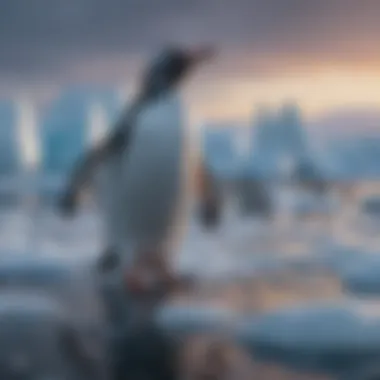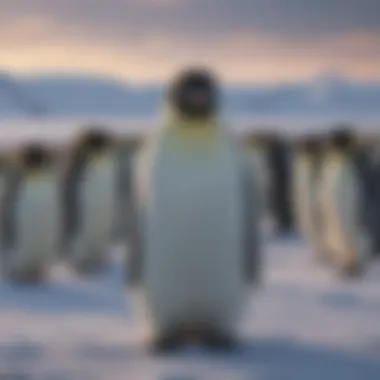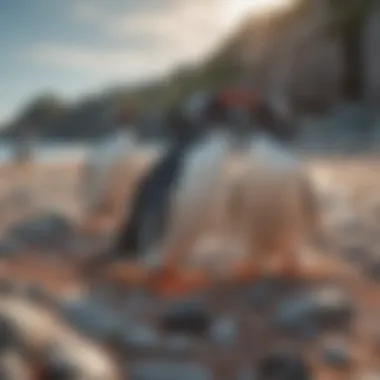Unveiling the Diverse Penguin Habitats: A Comprehensive Guide for Young Wildlife Enthusiasts


Nature Topic Overview
Welcome to the fascinating world of penguin habitats! In this comprehensive guide tailored for young nature enthusiasts, we will embark on a journey to explore the unique environments where these incredible birds thrive. From the icy expanses of Antarctica to the rugged shores of subantarctic islands, get ready to unravel the secrets of how penguins adapt to diverse ecosystems.
Fun Facts and Trivia
Dive into some fascinating facts about penguins that will captivate young readers' attention. Did you know that penguins can swim at speeds of up to 15 miles per hour? Moreover, to keep warm in chilly waters, penguins have thick layers of blubber under their skin. These engaging tidbits will spark curiosity and enrich your knowledge about these remarkable birds.
Wildlife Explorations
Let's delve into the world of different penguin species and their habitats. Discover how each species copes with its unique environment, from the majestic Emperor Penguins of Antarctica to the vibrant Chinstrap Penguins of the South Sandwich Islands. Explore interactive features like fun quizzes and puzzles that will make learning about penguins informative and entertaining.
Environmental Awareness
Understand the critical importance of conservation and sustainability in preserving penguin habitats. Learn about the impact of climate change and human activities on these fragile ecosystems. Find practical tips on how children can contribute to protecting nature, inspiring them to become young environmental stewards.
DIY Nature Activities
Engage in hands-on activities and experiments that will deepen your understanding of penguins and their habitats. Explore step-by-step guides for creating nature-inspired crafts or projects, such as building a penguin habitat diorama or crafting recycled materials into penguin-themed art. Embark on outdoor explorations to observe local wildlife and apply your newfound knowledge in the field.
Introduction to Penguin Habitats
In this comprehensive guide on penguin habitats, we delve into the intricate environments that serve as homes for these fascinating creatures. Understanding the significance of penguin habitats is crucial as it sheds light on how these birds adapt to diverse surroundings. Young nature enthusiasts embarking on this exploration will gain valuable insights into the unique ecosystems that support penguin life.
The Significance of Habitat for Penguins
Diversity of Penguin Species
Exploring the diversity of penguin species is imperative to grasp the complexity of these habitats. Penguins exhibit a wide range of characteristics, from the regal Emperor Penguins to the playful Adélie Penguins. This diversity plays a pivotal role in maintaining the balance of marine ecosystems, showcasing a rich tapestry of adaptations and behaviors that contribute to the overall vitality of these habitats.
Impact of Climate Change
Delving into the impact of climate change on penguin habitats reveals a pressing concern for the survival of these creatures. Rising temperatures and melting ice pose significant threats to penguin populations, disrupting breeding patterns and food availability. Understanding this aspect underscores the urgent need for conservation efforts to mitigate the adverse effects of climate change on penguin habitats.
Importance of Conservation Efforts
The importance of conservation efforts cannot be overstated when it comes to safeguarding penguin habitats. Conservation initiatives play a pivotal role in preserving the delicate balance of these ecosystems, offering hope for the long-term survival of penguin species. By highlighting the significance of conservation, we emphasize the collective responsibility to protect and sustain these habitats for future generations.
Adaptations to Harsh Environments


Exploring how penguins adapt to harsh environments unveils the remarkable strategies that enable their survival in challenging conditions. These adaptations showcase the resilience and ingenuity of penguins, underscoring their ability to thrive in some of the harshest environments on the planet.
Thick Layer of Blubber
The thick layer of blubber encapsulating penguins serves as a vital insulation against the icy cold of their habitats. This adaptation provides essential warmth and energy reserves, enabling penguins to withstand extreme temperatures and harsh weather conditions. The evolutionary advantage of this blubber layer is evident in the endurance and resilience it offers penguins in their frosty surroundings.
Waterproof Feathers
Penguins' waterproof feathers are a marvel of adaptation, allowing these birds to navigate the frigid waters with ease. The unique structure of their feathers repels water, keeping penguins dry and buoyant while swimming. This adaptation is a key survival mechanism for penguins, enabling them to pursue prey underwater and maintain their body temperature in the challenging marine environments they inhabit.
Countercurrent Heat Exchange
The countercurrent heat exchange system in penguins' circulatory system is a biological marvel that helps regulate their body temperature efficiently. This specialized adaptation allows penguins to retain heat in their core areas while minimizing heat loss in their extremities, optimizing their thermoregulation in cold environments. The effectiveness of this heat exchange mechanism is crucial for penguins' survival in the Antarctic and subantarctic regions, where temperatures can plummet to extreme lows.
Antarctic Habitats: The Frozen Realms
Antarctic Habitats are a crucial focus in this comprehensive guide to penguin habitats. The frozen realms of Antarctica provide a unique environment where penguins exhibit remarkable adaptations to survive and thrive in extreme conditions. These habitats play a vital role in the overall ecology of penguin species, shaping their behavior, breeding patterns, and interactions with other wildlife. Understanding Antarctic Habitats is essential for young nature enthusiasts to grasp the resilience and biodiversity of penguins in the harshest of environments.
Iceberg-dotted Landscapes
Penguin Breeding Colonies
Penguin Breeding Colonies are a pivotal aspect of Antarctic Habitats, serving as vital locations where penguins gather to reproduce and raise their young. These colonies showcase a diverse range of species coming together for breeding purposes, emphasizing the communal nature of penguins. The key characteristic of Penguin Breeding Colonies lies in their strategic placements, often near food sources and safe from predators, ensuring chicks' survival. Their unique feature includes the formation of tightly knit social structures among penguins, fostering cooperation and protection within the colony.
Challenges of Icy Terrains
The Challenges of Icy Terrains in Antarctica present penguins with numerous obstacles to overcome in their quest for survival. From navigating through ice floes to enduring harsh weather conditions, penguins must adapt to the unforgiving environment to thrive. The key characteristic of these challenges is the need for penguins to develop specialized physical traits and behaviors to combat the extreme cold and limited resources. Although daunting, these challenges also provide opportunities for penguins to showcase their resilience and evolutionary adaptations.
Wildlife Interaction
Wildlife Interaction in Antarctic Habitats introduces penguins to a diverse array of species living in the same environment. Penguins engage in complex interactions with other organisms, such as seals, seabirds, and marine predators, shaping their ecological roles and social dynamics. The key characteristic of wildlife interactions lies in the interconnectedness of the Antarctic ecosystem, where each species plays a crucial part in maintaining balance and biodiversity. Penguins' unique feature in these interactions is their role as both predators and prey, highlighting their position at the center of the Antarctic food web.
Feeding Grounds in the Southern Ocean
Rich Marine Biodiversity
Rich Marine Biodiversity in the Southern Ocean sustains penguins' dietary needs and provides essential nutrients for their survival. Penguins rely on the abundant marine life present in these feeding grounds to fuel their daily activities and meet their energy requirements. The key characteristic of Rich Marine Biodiversity is the variety of fish, krill, and other prey species available, ensuring a balanced diet for penguins. This unique feature enables penguins to thrive in the competitive marine ecosystem while adapting to changing environmental conditions.
Predator-Prey Dynamics


Predator-Prey Dynamics shape the intricate relationships between penguins and their predators in the Southern Ocean feeding grounds. Penguins must navigate the predator-prey interactions to secure their food sources and evade potential threats from marine predators. The key characteristic of these dynamics is the constant balance between predator and prey populations, influencing penguins' foraging behaviors and movement patterns. Penguins' unique feature in predator-prey dynamics is their evolutionary strategies to avoid predation and outmaneuver their opponents in the quest for survival.
Impact of Fisheries
The Impact of Fisheries presents a significant challenge to penguin habitats in the Southern Ocean, affecting both penguins and their prey species. Overfishing and unsustainable fishing practices can deplete prey populations, leading to food shortages for penguins and disrupting the marine ecosystem's balance. The key characteristic of this impact is the need for sustainable fishing management to mitigate adverse effects on penguins and promote long-term ecological sustainability. Penguins' unique feature in this context is their vulnerability to changes in prey availability, highlighting the interconnected nature of human activities and penguin habitats in the Southern Ocean.
Subantarctic Habitats: Islands of Diversity
Located in the vast Southern Ocean, Subantarctic Habitats are essential in Understanding Penguins. These Islands brim with a plethora of Flora and Fauna native only to these unique locations. The significance of Subantarctic Habitats lies in the untouched ecosystems that offer valuable opportunities Diverting youth's attention towards exotic biodiversity existing in a sublime balance. Students and enthusiasts navigate around this distinct island ecosystem embodying a Cradle teeming with Biological Marvels.
Diverse Island Ecosystems
Unique Flora and Fauna
The Subantarctic Islands boast Unique Flora and Fauna species adapted to harsh environments. These Organisms exhibit Special Characteristics aiding Survival and Thriving in uncharted Biomes. The islands' Unique Flora and Fauna contribute significantly to the Environmental Fabric, with rare plants providing Vital Nourishment and shelter for local Fauna. Studying the Unique Flora and Fauna enhances Understanding of Ecosystem Interactions, representing a Central Pillar in Environmental Education and Scientific Discovery amidst young learners.
Seabird Nesting Sites
Seabird Nesting Sites dot the island landscapes, offering Safe Havens for avian species to rear their offspring. These Prime Spots serve as Vital Sanctuaries vital to Avian Life Cycles, providing Shelter from Predators and Harsh Climate conditions. Understanding the Dynamic Interplay between Seabirds and their Nesting Sites cultivates an Appreciation for the Delicate Balance in island ecosystems, highlighting the Importance of Conservation to safeguard these crucial Breeding grounds.
Climate Variability
The islands' Climate Variability presents a tableau of ever-changing weather patterns, shaping the dynamics of local Ecologies. This Fluid Environment challenges the Flora and Fauna to adapt swiftly, showcasing Resilience and Flexibility in the face of Environmental Adversities. Analyzing the Impacts of Climate Variability on island life illuminates the Fragile Equilibrium present in these ecosystems, underscoring the Urgency of Sustainability practices for long-term Resilience and Biodiversity Preservation.
Penguin Adaptations to Island Life
Colonial Nesting Behavior
Penguins exhibit Colonial Nesting Behavior, congregating in Large Groups for Efficiency and Community support. This Social Structure aids in Cooperative Nesting and Defense Mechanisms against Predators. Diving into the intricacies of Colonial Nesting Behavior unveils the Complex Social Fabric within Penguin Colonies, enabling young enthusiasts to grasp the Significance of Communal Living among these Endearing Birds.
Predator Avoidance Strategies
Penguins employ various Predator Avoidance Strategies such as Camouflage, Agility, and Group Vigilance to mitigate threats from Seaborne predators. These Adaptations showcase Penguins' Evolutionary Resilience and resourcefulness in Evading danger within their island habitats. Exploring the nuances of Predator Avoidance Strategies unveils the Astonishing array of Tactics employed by Penguins to ensure survival, offering a glimpse into the Dynamic Interactions between Predators and Prey in island ecosystems.
Feeding Behavior
Penguins exhibit distinct Feeding Behaviors, adapting to forage in diverse aquatic environments surrounding the islands. From High-speed Pursuit Diving to Filter-feeding, these strategies showcase Penguins' Adaptive Mastery of the Island's rich marine Resources. Delving into the intricacies of Penguin Feeding Behavior illuminates the Finely-tuned Relationship between Penguins and their Food sources, underscoring the intricacies of Food Chains and Ecosystem dynamics present in Subantarctic environments.
Human Impacts on Penguin Habitats


In this article, delving into the crucial topic of Human Impacts on Penguin Habitats is paramount as it sheds light on the interactions between humans and penguin ecosystems. Understanding the repercussions of human activities on these delicate habitats is essential for fostering conservation efforts. By exploring the specific elements of overfishing, pollution, and tourism disturbances, readers can grasp the significant role humans play in shaping penguin habitats.
Threats to Penguin Habitats
Overfishing and Depletion of Prey
Overfishing and the subsequent depletion of prey species present a substantial threat to penguins' survival. The excessive exploitation of fish stocks disrupts the food chain, impacting the availability of essential prey for penguins. This unsustainable practice poses a serious challenge to the stability of marine ecosystems, ultimately endangering penguin populations. Understanding the detrimental effects of overfishing is crucial for addressing this pressing issue and safeguarding penguins.
Impact of Pollution
Pollution, whether from land-based sources or marine activities, poses a pervasive threat to penguin habitats. The introduction of pollutants such as plastics, chemicals, and oil can have devastating consequences on marine life, including penguins. These pollutants not only degrade the physical environment but also harm penguins directly through ingestion or entanglement. Recognizing the harmful effects of pollution on penguin habitats underscores the need for stringent environmental regulations and proactive conservation measures.
Disturbance from Tourism
Tourism, while providing economic benefits, can significantly disturb penguin habitats if not managed sustainably. The influx of visitors to penguin colonies can lead to habitat degradation, stress on wildlife, and alterations in natural behaviors. Balancing the economic opportunities of penguin-based tourism with conservation considerations is vital to mitigate the negative impacts of human presence on these fragile ecosystems. By fostering responsible tourism practices, we can minimize disturbances and protect the ecological integrity of penguin habitats.
Conservation Initiatives
Marine Protected Areas
The establishment of Marine Protected Areas (MPAs) plays a critical role in safeguarding penguin habitats and promoting biodiversity conservation. MPAs serve as designated zones where human activities are regulated to protect marine ecosystems and species, including penguins. By delineating protected areas, researchers and policymakers can monitor ecosystem health, prevent overexploitation, and ensure the long-term sustainability of penguin habitats. The creation of MPAs represents a proactive approach to conservation that aims to balance human needs with ecological preservation.
Research and Monitoring Programs
Research and monitoring programs are instrumental in understanding the dynamics of penguin habitats and assessing the impacts of human activities. Through scientific research, experts can gather data on penguin populations, habitat quality, and environmental trends to inform conservation strategies. By implementing long-term monitoring initiatives, conservationists can track changes in penguin habitats, identify threats, and evaluate the effectiveness of conservation measures. Investing in research and monitoring is essential for informed decision-making and the preservation of penguin habitats.
Community Engagement
Engaging local communities in conservation efforts is pivotal for fostering stewardship and generating support for penguin habitat protection. Community involvement allows for the sharing of knowledge, resources, and responsibilities in conserving penguin ecosystems. By collaborating with stakeholders, conservation organizations can raise awareness, implement conservation projects, and empower communities to become active participants in safeguarding penguin habitats. Promoting community engagement cultivates a sense of ownership and collective responsibility towards protecting the natural heritage of penguins and their habitats.
Conclusion
The conclusion of this comprehensive guide on penguin habitats serves as a pivotal moment to reflect on the significance of understanding and appreciating these unique environments where penguins thrive. By delving into the intricacies of their habitats, young nature enthusiasts can develop a profound connection with these fascinating birds and the delicate ecosystems they inhabit. The conclusion not only encapsulates the key takeaways discussed throughout the article but also emphasizes the crucial role of conservation efforts in protecting these environments for future generations.
Appreciating Penguin Habitats
Educational Opportunities
Exploring educational opportunities related to penguin habitats offers a dynamic platform for young learners to engage with environmental science and wildlife conservation. By immersing themselves in the study of penguin ecosystems, children can cultivate a deeper appreciation for the natural world and the importance of biodiversity. Educational programs focusing on penguin habitats provide hands-on experiences, scientific knowledge, and conservation principles, empowering the next generation of environmental stewards. These opportunities ignite curiosity, foster critical thinking skills, and instill a sense of responsibility towards preserving our planet's diversity.
Call to Action for Conservation
The call to action for conservation embedded within the exploration of penguin habitats motivates readers to actively participate in safeguarding the future of these charismatic birds. Encouraging individuals to take small yet impactful steps towards conservation efforts, such as reducing plastic usage, supporting sustainable fishing practices, and advocating for marine protected areas, can collectively contribute to the preservation of penguin habitats. By harnessing the power of collective action, we can strive towards a sustainable coexistence with nature, ensuring the survival of penguin populations and the ecosystems they depend on for survival.
Inspiring Future Generations
Inspiring future generations through the lens of penguin habitats sparks a sense of wonder and responsibility in young minds, encouraging them to become agents of positive change in environmental conservation. By showcasing the resilience and adaptability of penguins in the face of environmental challenges, children are inspired to emulate these qualities in their own lives, promoting resourcefulness, empathy, and a deep respect for nature. By nurturing a generation that values sustainability, ethical stewardship, and harmonious cohabitation with wildlife, we pave the way for a brighter future where humans and penguins thrive together in balance and mutual respect.







